It isn’t enough to write a blog post (even a really good one!), declare it content marketing, and then drive traffic there for the rest of eternity. What really makes a strong content marketing strategy is the willingness to always be working on it, to be innovating, and to create fresh and exciting content often. Here are some tips and best practices to help you get started.
Now, I understand that that’s easier said than done. How do you ensure that content is fresh? Where do you even get the ideas or inspiration to keep coming up with new examples? The answer is, there are many ways to get inspired about content marketing, but these—in my humble content marketer opinion—are some really great places to start.
Getting started creating an effective content marketing strategy requires a strong understanding of what makes great content marketing so…great.
One of the best things about content marketing is how truly customizable it is. As we run through some of the best examples in the biz, I’ll call out the ways that different industries tailor content marketing to best fit their audience’s needs as well as their business needs, and how you can take those same principles and apply them whether you’re in that specific industry or not.
I hope these creative content marketing examples inspire you and leave you feeling, indubitably, that content marketing is completely within your reach.
Digital Marketing Content Writing Examples
Let’s explore how brands leverage different kinds of writing to fuel strong content marketing.
1. Teachable’s Mini Course Checklist

It’s no surprise that Teachable, a platform that helps people create and sell online courses, is full of experts on, well, creating courses.
There’s a variety of ways that Teachable could leverage this knowledge base to create content, and creating a simple, snackable checklist lead magnet is a fantastic one.
After collecting an interested consumer’s email address, Teachable sends out their thoughtfully-created checklist that makes the idea of creating a mini course seem way less intimidating than it might have previously (I, for one, would have no idea where to begin).
The good news about checklists is that they can be created for anything. Seriously, anything. A checklist for creating an app, a checklist for optimal kitchen organizing, a checklist for making a checklist. You get the point—checklists are very adaptable.
So, how can you create a piece of content like this? Key takeaways:
- Collect leads. You’ve created a stellar piece of content, and it’s worthy of someone giving you their email in exchange for access to it.
- Remove intimidation barriers. Creating an online course (or doing/buying whatever it is you offer) may sound like a lot of work to someone who’s never done or purchased it before. Ask your sales teams for common rejections or reasons for not purchasing, and then break it down into an easy-to-digest checklist. You may effectively remove one of your most common sales barriers.
- Be an expert. I mentioned it above, but you truly can create a checklist for anything. Think about what you specialize in and turn it into a list.
2. Cuseum’s Webinar Series
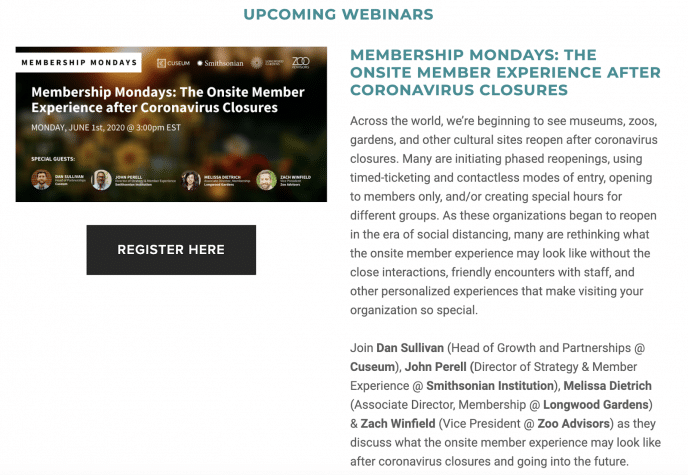
Cuseum helps to power mobile apps or digital memberships for museums, public attractions, and cultural institutions. They care about art and culture, and it’s their mission to help keep these beloved parts of society alive and well.
They regularly create all kinds of content, from e-books, to case studies, and more, but they’ve recently ramped up the production of webinars in response to Coronavirus, a pivot they felt would best serve their existing and potential clients.
In exchange for an email address, registrants gain access to these virtual sessions. This lead generation strategy is an example of one that has something in it for the customer––a webinar that is pertinent to them (they signed up for it) and information they want or need.
Webinar-like content is far from industry-specific. Here’s how you can do something similar:
- Be timely and willing to pivot. This goes for all types of content marketing, but considering what your audience may want at a given moment and why they want it can help you better exert effort into resources that people will want to consume.
- Focus on the topics of utmost relevance to your audience. I’ll mention this a few times, but content marketing hinges on knowing your audience and knowing them well. If you don’t feel like you know them that well, get to know them! Leverage your social media channels or emails to put out a call for the type of webinar or virtual interview that your audience feels would be most relevant for them.
- Ask for information. Creating a webinar isn’t a walk in the park—you’ve worked hard to create this piece of content and (hopefully) you’ve made it really valuable to your audience. Exemplify how valuable you know it is by asking for the type of information you need to collect to consider somebody a lead.
Interactive Content Marketing Examples
Everybody loves a game, quiz, or survey, which lends itself to a fun way to embark on the content marketing journey—creating interactive content.
1. Glossier’s Skincare Quiz
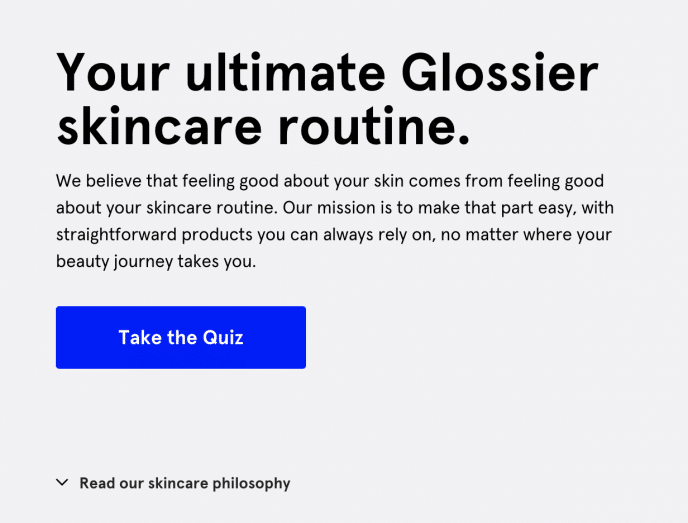
Beauty disruptor Glossier put together a quippy quiz designed to help consumers gain a better understanding of their skincare needs. The connection to their products is obvious, but giving customers something to do that’s all about them can leave a really good impression, and perhaps even get somebody so invested that they’d then consider becoming a customer as a result.
The quiz goes on to ask lighthearted and relatable questions like “How does your skin feel on a normal day?” and “How many steps are you willing to commit to?”, all met with answers on-brand with their voice.
At the end of the quiz (you guessed it), Glossier provides a customized collection of products to match the consumer’s specific quiz results.
So, how can you replicate something like this, beauty industry or otherwise? Key takeaways:
- People love talking about themselves. Ask them questions that are all about them—what could be more audience-focused than that?
- Keep brand voice at the forefront of something like this. A quiz is a perfect time to showcase a unique sense of humor, an industry authority, a nurturing tone, or any other voice your team is working to craft.
- Think about linking back to your product as a continuation of the resource you’re providing rather than hard selling.
2. Oreo’s Concert on a Cookie
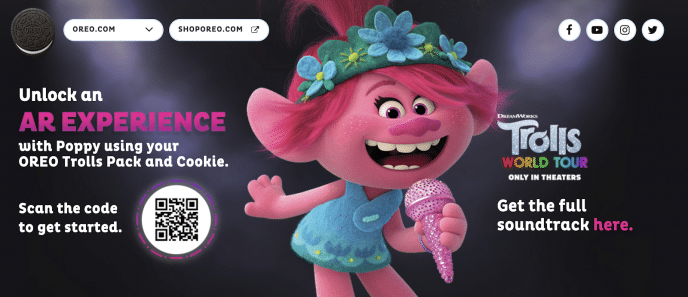
Oreo is no stranger to interactive content, but this time they’ve really created something entertaining. When a person scans the provided QR code, they’re given access to an Instagram filter that, when an Oreo cookie is present, creates a virtual Trolls concert right on top of the cookie.
This is smart content marketing for a multitude of reasons. It loops in a relevant and exciting partner, it takes consumers on a quick adventure, and it requires you to have an Oreo cookie on hand to get the full experience.
This content is light-hearted, but well thought out, and it certainly leaves you (or at least me) wanting on Oreo cookie.
So how can you do something like this even if you can’t score a big partner or have massive brand recognition? Key takeaways:
- Remember the little adventures. Creating interactive content doesn’t have to mean taking consumers through something extravagant. Sometimes something as simple as scanning a QR code with a little bit of mystery can get people intrigued.
- Make it current. If you can’t get the Trolls on board, I get it, but you don’t have to think that big. Examine something that’s currently relevant, even if that’s just a trend people are catching on to (dancing videos, virtual conferencing, etc.), and make it a part of your experience.
Creative Content Marketing Examples
Sometimes, the key to successful content marketing is just getting a little bit creative. Thinking about your consumer as more than just a consumer of your product (what might they be seeking? What interests can I assume they have based on their having landed on me?) can help you create content that’s most relevant to them.
1. Misfits Market Recipes
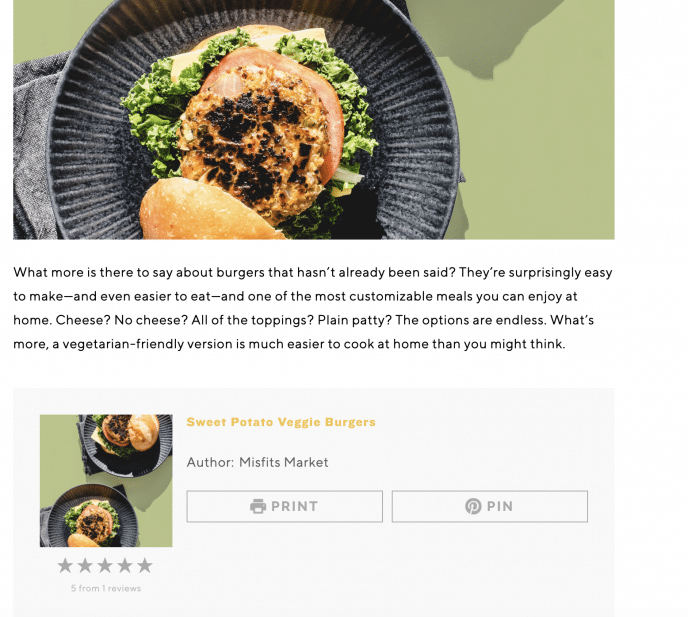
In their journey to end food waste, weekly food subscription service Misfits Market encounters a lot of foodies. So, when it comes to creating content, why not create something that every foodie likely devotes a lot of their time online to—recipes.
Misfits Market creates seasonal, simple recipes and accompanies them with beautiful imagery, ingredient lists, and a subtle (and equally beautiful) call-to-action (CTA) image in case reading about food inspires someone to sign up for their service.
While recipes themselves may seem specific to food or crafts, this same principle can be applied in a broader sense to all kinds of industries. It’s all about inferring what people who would be interested in your product would also be interested in—anticipate their wants and needs outside of just your product.
Key takeaways here:
- Map out your audience and get to know them like the back of your hand. They care about fitness, so maybe they’d be interested in an interview with a professional athlete. They care about the environment, so maybe they’d enjoy a video of some of the most beautiful places on the planet. Place them within the context of their lives to create content they’ll want and need.
- Seize the opportunity to be an authority. You want a potential consumer to view you as the best in the biz, or at least certainly to think you know what you’re talking about. Create content that exemplifies that you have the chops, and if they’re shopping within your industry, you clearly know your stuff enough to be the right choice to do business with.
2. Pressed Juicery’s The Chalkboard

In a stunning example of creativity, popular smoothie spot Pressed Juicery created a content marketing outlet so audience-focused that you may not even immediately notice it’s coming from them. Talk about not making a hard sell whatsoever.
The Chalkboard is a digital magazine covering everything from sustainable beauty, to interviews, all the way down to—here it is—some content directly related to Pressed Juicery. Not all, but some.
By creating content that feels genuinely beneficial to the audience without the all-too-familiar constant selling, Pressed Juicery has created a space that consumers actually want to be in. Pretty impressive, if you ask me.
So, how can you emulate this idea even if you do it a little differently? Key takweaways:
- Take a risk and give your content channel its own name. Let me preface this one by saying it isn’t for everyone, but it can pay off. By giving your content channel a different name, you immediately remove any qualms of feeling “sold to.” So long as your name is somewhere (Pressed Juicery does appear in the drop down menu on The Chalkboard), you can be present without being present.
- Go the extra mile for your customers. Create something useful, beautiful, something different. A lot of brands have a blog—try interviewing industry experts, or doing round-ups of products (not related to your own), and watch yourself become a repeat part of someone’s digital morning peruse.
- Of course, bring it back to yourself some of the time. You’re here to be a resource, but you also have a business to run. Find ways to pepper in useful content that does link directly to you. You’ve earned trust by not doing it all the time, so when you do it, it leaves a better taste.
Content Marketing Article Examples
One portal into content marketing with a relatively low barrier of entry is the creation of a blog. On a blog, you can step into the beloved, tried-and-true content marketing of writing articles, and wind up becoming a part of your potential consumers’ online experience.
1. Grow by Acorns + CNBC
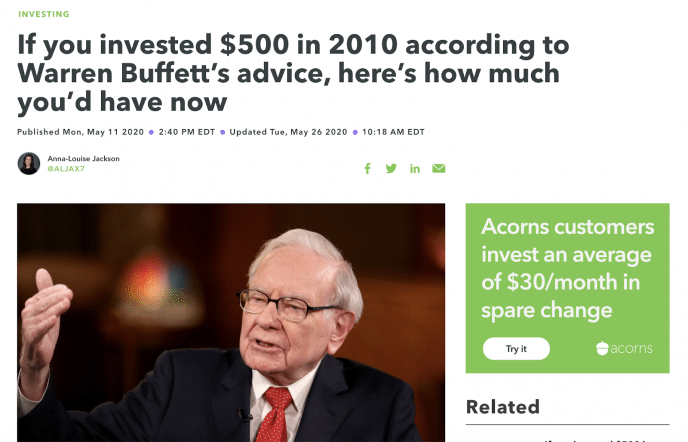
In partnership with CNBC, money management disruptor Acorns has created a blog known as Grow, where they create relevant and informative written content that goes beyond just storytelling.
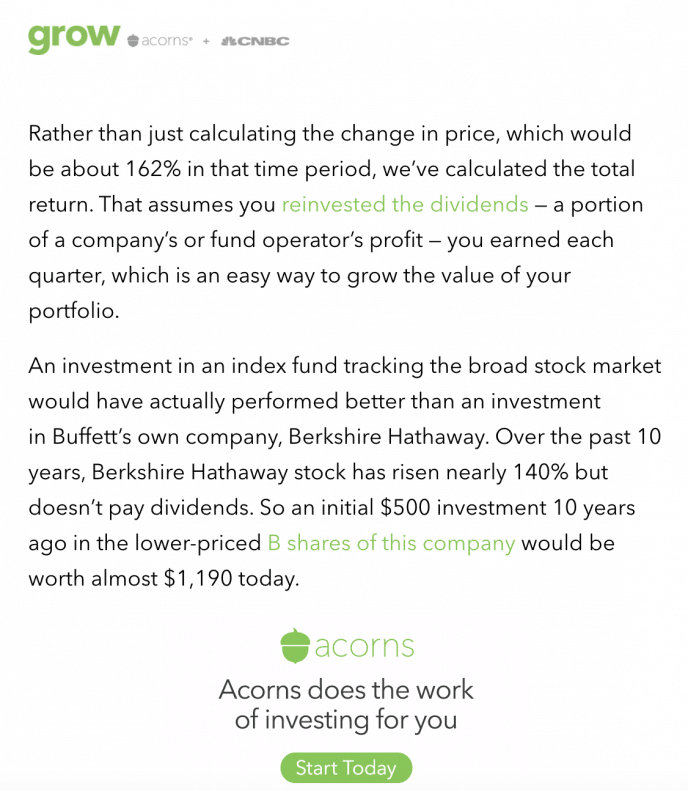
Acorns prides themselves on being a resource for their customers and potential customers, and they make it relatively simple and straightforward by creating robust article content that offers up CTAs where appropriate.
This approach to content marketing quickly establishes Acorns as an authority in the finance space, but does so in a way that’s timely and accessible for people of all ages, financial needs, and financial know-how.
They include articles with titles such as “How a 20-something who saved $100,000 in 3 years is adjusting her saving during coronavirus,” “How to avoid a common mistake that costs investors money,” and “Free ways to enjoy the ‘unprecedented levels of media’ people are consuming in lockdown.”
What Acorns has created is a diverse but always relevant mix of content that fits seamlessly into their consumers’ lives.
Here’s how you can do something like this too:
- Just start blogging. You don’t have to go from 0 to 100 overnight—building up a blog takes time, but everyone has to start somewhere. Start by creating a few pieces of content a month and gradually increase that number over time as you start seeing traction.
- Let your article content position you as an expert. Odds are, your team are experts in whatever it is you do. Leverage that and create expert content and/or reach out to other industry experts to see if you can interview them to up that authority level.
- Speak to everyone. When you’re creating article content, consider someone who has never heard of what you do or sell, to someone who’s aware but maybe hasn’t made a decision, all the way down to someone who is, themselves, somewhat of an expert. Create content that speaks to different audiences.
2. The Dog People by Rover

Rover is a digital marketplace helping connect pet owners with qualified service providers for pet sitting, walking, grooming, and more. Their aptly titled blog (they love cats, too!) features a wealth of pet resources.
Rover creates text-based content that addresses so many of the moments pet owners experience in their everyday lives. Their article content ranges from more serious topics covered to the more lighthearted, but always maintains the company’s passion for pets.
Key takeaways:
- Consider what situations a customer of yours might encounter in life. In the fashion industry? Write about how to transform a summer wardrobe into a winter one, or tips on how to organize a closet for the easiest outfit assembling. Fitness industry? Explain the benefit of burpees (everyone loves burpees, right?), or what amount of exercise people should really be aiming for each day.
- Make your passion the forefront. I hope you love what you do, and I hope you work with other people who love it too. Let that passion and excitement fuel the content you create. If you’re passionate about it, odds are other people will be too. Especially your potential customers.
Your Own Foray Into Content Marketing
We’ve covered content marketing examples across a variety of techniques and industries, which means now it’s time to really distill it down and get you ready to work on content marketing of your own.
A few key takeaways I hope you walk away from these examples with:
- Take a page from Teachable and Cuseum’s playbooks and create a piece of gated content
- Provide value for your audience—give them a reason to give you information in return
- Like Glossier’s quiz and Oreo’s website-to-social entertainment experience, your content doesn’t have to be static
- Let interactive content be a time for your audience to talk about themselves or participate in something that feels culturally relevant to them
- There’s no one-size-fits-all approach to content marketing, as companies like Misfits Market and Pressed Juicery know.
- Think outside the box and create content that may not be directly related to your product, but still relates back, and don’t be afraid to really remove branding.
- There is nothing wrong with a good, old-fashioned article. Just ask Acorns and Rover.
- When you’re creating article content, put yourself in your customers’ shoes. What types of things do they care about reading? What challenges might they encounter that you can write about?
I could talk about the importance of content marketing all day, but instead, I’ll leave you with this. In a world where people have become so guarded against being sold to, continuing to just sell to them simply is not the right solution.
Customer acquisition, retention, and loyalty don’t happen overnight. Create content that draws people to you, makes people want to stay, and that makes people want to keep on coming back for more. And don’t just set it and forget it, either; continue to create.